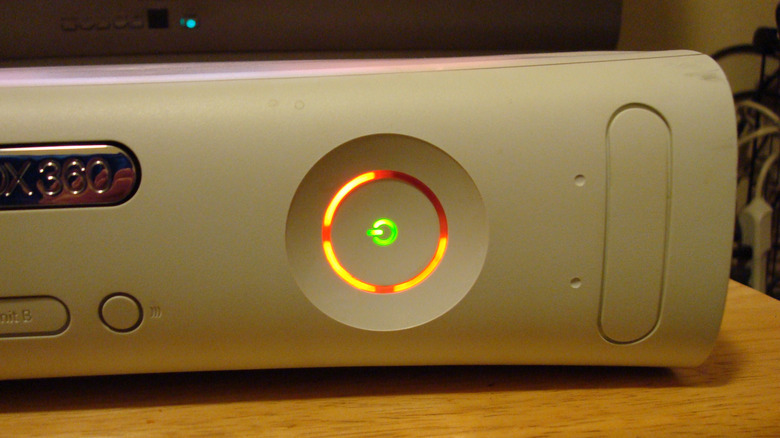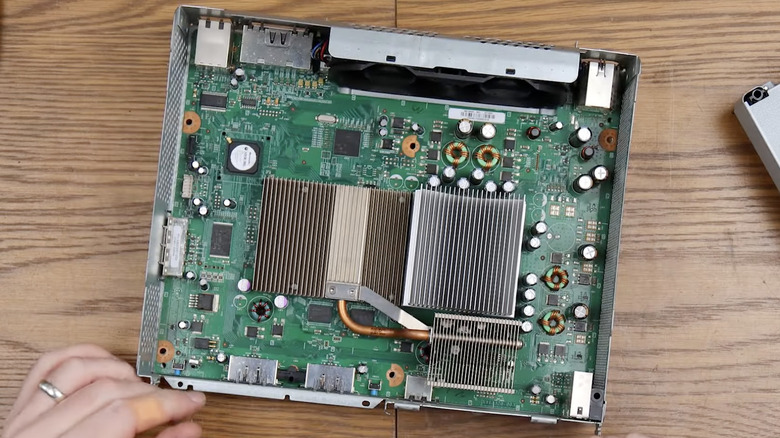Xbox's Billion Dollar Problem Nearly Ruined It Forever
When Microsoft's second home video game console, the Xbox 360, was released in November 2005, it was a pretty big deal. Most notably, it was the first console capable of rendering and outputting high definition graphics — and it did this while hitting stores a year before its direct competitor in Sony's PlayStation 3, the Japanese tech powerhouse's own first HD console.
The original Xbox had been a major success during the upheaval that was the sixth generation of video game consoles; one that featured Sega's hardware swan song in the Dreamcast, the runaway juggernaut that was the Sony PlayStation 2, and Nintendo losing ground with its GameCube console. With Microsoft now a major competitor in the console wars and establishing popular IP like the "Halo" franchise, the launch of the 360 was hotly anticipated. Xbox seemed primed to use its head start to dominate its PS3 rival, as well as Nintendo's underpowered, eccentric Wii hardware.
Quickly, though, there ended up being a massive monkey wrench thrown into the mix. A distressingly disproportionate subset of Xbox 360 owners found their consoles displaying the unit's generalized error message: A combination of red lights that was soon dubbed the "Red Ring of Death." Gamers, Microsoft, and third-party technicians all sought out to find a solution to a vague problem that involved poor thermal design, and eventually, Microsoft did its best to rectify the issue.
What was the most common cause of the Red Ring of Death?
As much as the move into HD console gaming and Xbox exclusives made the Xbox 360 a major commercial success, its legacy is also marred by a widespread, critical hardware defect. Dubbed the "Red Ring of Death" for the illuminated shape it formed on the console's front panel, it was (technically) a generalized error message for hardware issues. In practice, though, it became closely associated with a major thermal issue that rendered a disproportionately large number of Xbox 360 consoles unusable.
Though poor thermal design was what generally received blame, it wasn't a more obvious problem like overheating. It wasn't until 2021, well after the console's end of life, that Microsoft fully explained what happened in an entry in the Xbox documentary series on the brand's official YouTube channel.
"The breakthrough came when we understood that the connections that were being broken were not located on the motherboard, but they were actually located inside the components," explained Xbox hardware engineer Leo Del Castillo in an interview included in the documentary. "The reason it was breaking was thermal, but it wasn't because of peak temperature. It was because, when the unit would get hot and then cold ... every time it did that, [the temperature change] would stress the connection." At the time, though, this wasn't inherently known by Microsoft or even the third-party electronics repair community.
How Microsoft handled the Red Ring of Death epidemic
When it came time for Microsoft to publicly acknowledge the "Red Ring of Death" and announce a plan to fix affected consoles, the solution seemed fair. The company extended the usual one-year warranty (two years in some countries) to three years for "red-ringed" consoles; complete with free shipping for the repairs, plus reimbursing customers who'd previously paid to fix such consoles. This was announced via an open letter from Microsoft executive Peter Moore that was posted to the company website in 2007.
"If we have let any of you down in the experience you have had with your Xbox 360, we sincerely apologize," he wrote. "We are taking responsibility and are making these changes to ensure that every Xbox 360 owner continues to have a great experience." On behalf of the whole company, he also thanked the Xbox 360 users for their "loyalty" to the brand during an incredibly frustrating situation. All told, in the aftermath of this announcement, Microsoft paid $1.15 billion to fix red-ringed Xbox 360 consoles and reimburse those who'd been forced to pay for service.
Moore reflected on the situation eight years later on Podcast Unlocked (via EuroGamer). "If you're an Xbox gamer, you can thank Steve Ballmer for not even hesitating [to pay the $1.15 billion]," he said. "If we hadn't made that decision there and then, and tried to fudge over this problem, then the Xbox brand and Xbox One wouldn't exist today."



